SPOA3 Specific Populations and Older Adults - Case Study 1
Prepare a response to a case study on specific populations and older adults.
32 Pages7204 Words367 Views
Added on 2022-12-14
About This Document
This document is a case study for SPOA3 Specific Populations and Older Adults. It provides instructions for accessing pre-exercise screening tools for special population clients and includes questions to answer based on the case study.
SPOA3 Specific Populations and Older Adults - Case Study 1
Prepare a response to a case study on specific populations and older adults.
Added on 2022-12-14
ShareRelated Documents
SPOA3 Specific populations and older adults
Case Study 1 v1.6 (2018/12/20)
SPOA3 Specific populations and older
adults
Name
Email address
Assessment© 2018 Australian Institute of Personal Trainers Pty Ltd and its licensors (AIPT)
Commonwealth of Australia Copyright Regulations 1969
Warning: This material has been reproduced and communicated to you by or on behalf of
AIPT, pursuant to Part VB of the Copyright Act 1968 (the Act).
The material in this communication may be subject to copyright under the Act. Any further
reproduction or communication of this material by you may be the subject of copyright
protection under the Act.
All rights are reserved. You must obtain the prior written permission of AIPT for the
republication or redistribution of any content. Do not remove this notice.
Case Study 1
Read through the following case study. You should reflect on your learning and
your own research within this unit.
Prepare a response that responds to each of the issues presented therein. Your
responses must reflect your knowledge, skills, and application for this unit.
These simulation assessments will be assessing the following units of
competency:
SISFFIT002 Recognise and apply exercise considerations for specific
populations
SISFFIT014 Instruct exercise to older clientsTask
1. Read the entire case scenario and each of the assessment tasks for this
unit of competency before commencing.
2. Answer all the assessment tasks. Keep in mind that you are studying a
nationally recognised Certificate III unit of competency.
3. Your answers must reflect the depth of knowledge and understanding
expected of a person who can work under supervision and demonstrate a
level of judgement and decision-making.
4. This assessment is to be conducted in your own time. Notes, textbooks,
and computers may be used.
5. You must complete your own work without assistance from others.
6. Each aspect of the assessment tasks must be assessed as satisfactory in
order to achieve a satisfactory result.
7. Complete the assessment sign-off sheet with your assessor/mentor.
1
Case Study 1 v1.6 (2018/12/20)
SPOA3 Specific populations and older
adults
Name
Email address
Assessment© 2018 Australian Institute of Personal Trainers Pty Ltd and its licensors (AIPT)
Commonwealth of Australia Copyright Regulations 1969
Warning: This material has been reproduced and communicated to you by or on behalf of
AIPT, pursuant to Part VB of the Copyright Act 1968 (the Act).
The material in this communication may be subject to copyright under the Act. Any further
reproduction or communication of this material by you may be the subject of copyright
protection under the Act.
All rights are reserved. You must obtain the prior written permission of AIPT for the
republication or redistribution of any content. Do not remove this notice.
Case Study 1
Read through the following case study. You should reflect on your learning and
your own research within this unit.
Prepare a response that responds to each of the issues presented therein. Your
responses must reflect your knowledge, skills, and application for this unit.
These simulation assessments will be assessing the following units of
competency:
SISFFIT002 Recognise and apply exercise considerations for specific
populations
SISFFIT014 Instruct exercise to older clientsTask
1. Read the entire case scenario and each of the assessment tasks for this
unit of competency before commencing.
2. Answer all the assessment tasks. Keep in mind that you are studying a
nationally recognised Certificate III unit of competency.
3. Your answers must reflect the depth of knowledge and understanding
expected of a person who can work under supervision and demonstrate a
level of judgement and decision-making.
4. This assessment is to be conducted in your own time. Notes, textbooks,
and computers may be used.
5. You must complete your own work without assistance from others.
6. Each aspect of the assessment tasks must be assessed as satisfactory in
order to achieve a satisfactory result.
7. Complete the assessment sign-off sheet with your assessor/mentor.
1
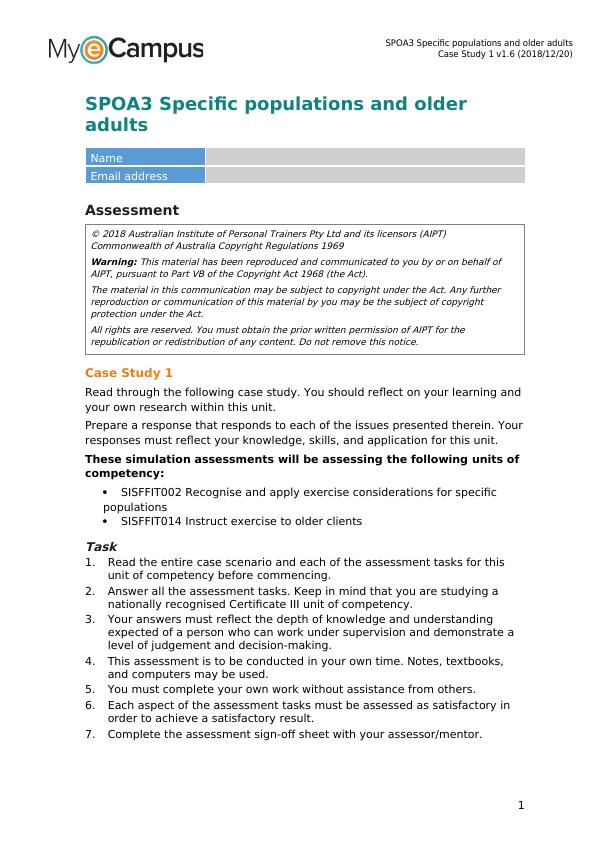
SPOA3 Specific populations and older adults
Case Study 1 v1.6 (2018/12/20)
In order to complete this assessment, you will need to access the ten (10) pre-
exercise screening tools for the following clients:
Mario Mendes
Alison Nosila
John Ode
Kate Keats
Anastasios Raptis
Kelly Brown
Kinu Honda
Pedro Sagan
Ann Marie
Janet Tena
The role of a fitness instructor requires understanding and identifying a client’s
contraindications to exercise and assessing whether the client requires a
referral to a more qualified allied health professional.
In this task, the student will be required to use industry-endorsed pre-exercise
screening tools and risk stratification processes to identify the risk level of the
following ten (10) special population clients. In doing so, the student will need
to ensure that the following criteria are met:
Review and advise client of outcomes of pre-exercise health screening
procedures.
Develop and document program plans that incorporate instructional
information and guidance from medical or allied health professionals if
required.
Discuss and confirm the client’s understanding of potential signs and
symptoms of intolerance contraindications to exercise and of recommended
precautions.
Refer client to medical or allied health professionals as required.
Determine the type of training, training methods, and equipment
required to achieve the client’s goals.Client 1: Mario Mendes
Review Mario’s pre-exercise screening tool, and answer the following
questions.
1. According to the risk stratification from stage 2, how many risk factors
does Mario have?
The patient of this case study is a male of 56 years of age. He is
suffering from 2 risk factors which involves the age related risk factor
and high blood sugar. He sometimes feel weak and dizziness.
2
Case Study 1 v1.6 (2018/12/20)
In order to complete this assessment, you will need to access the ten (10) pre-
exercise screening tools for the following clients:
Mario Mendes
Alison Nosila
John Ode
Kate Keats
Anastasios Raptis
Kelly Brown
Kinu Honda
Pedro Sagan
Ann Marie
Janet Tena
The role of a fitness instructor requires understanding and identifying a client’s
contraindications to exercise and assessing whether the client requires a
referral to a more qualified allied health professional.
In this task, the student will be required to use industry-endorsed pre-exercise
screening tools and risk stratification processes to identify the risk level of the
following ten (10) special population clients. In doing so, the student will need
to ensure that the following criteria are met:
Review and advise client of outcomes of pre-exercise health screening
procedures.
Develop and document program plans that incorporate instructional
information and guidance from medical or allied health professionals if
required.
Discuss and confirm the client’s understanding of potential signs and
symptoms of intolerance contraindications to exercise and of recommended
precautions.
Refer client to medical or allied health professionals as required.
Determine the type of training, training methods, and equipment
required to achieve the client’s goals.Client 1: Mario Mendes
Review Mario’s pre-exercise screening tool, and answer the following
questions.
1. According to the risk stratification from stage 2, how many risk factors
does Mario have?
The patient of this case study is a male of 56 years of age. He is
suffering from 2 risk factors which involves the age related risk factor
and high blood sugar. He sometimes feel weak and dizziness.
2
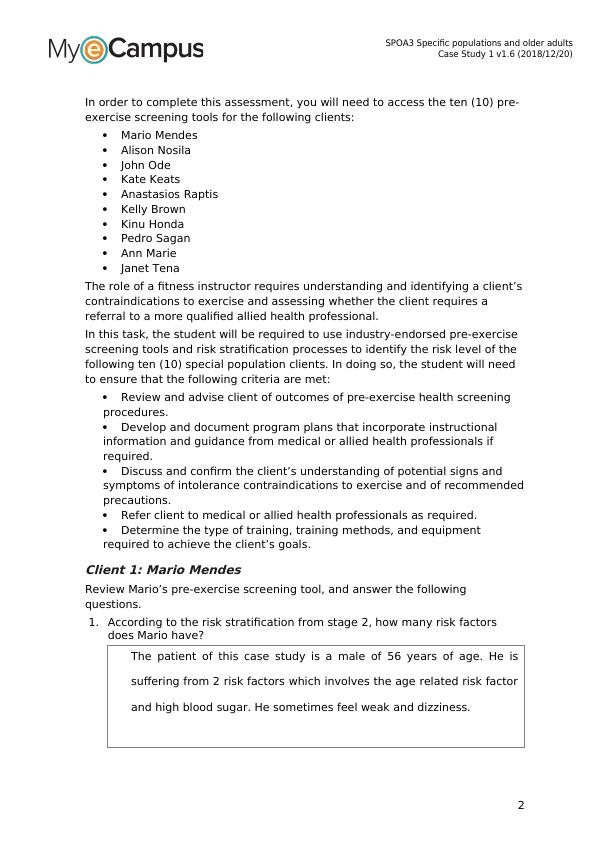
SPOA3 Specific populations and older adults
Case Study 1 v1.6 (2018/12/20)
2. Taking into consideration the results of stages 1 and stage 2, does the
client require a referral?
By considering the results of stages 1 and 2 it can be said that he
needs medical referral.
He needs a general physician to control the blood sugar and also a
dietician for preparing a new diet plan.1
4. From the list below, identify which health and fitness appraisals are
appropriate for Mario prior to referral.
• Blood pressure
• Girth measurements
• BMI
• Hip-to-waist ratio
• Queen’s College step test
• Shoulder flexibility test
• Wall sit test
• Push-up test
The fitness appraisals that the patient need before moving to the
doctor are blood pressure, BMI, ratio of hip to waist and push-ups.
5. Identify any common barriers to exercise from the pre-exercise screening
tool.
The barrier that the patient is suffering is the lack of interest to the
exercises.
6. Document the type of training methods, precautions, and equipment
required for Mario to exercise in a safe environment.
1 Padayachee, Cliantha, and Jeff S. Coombes. "Exercise guidelines for gestational
diabetes mellitus."
World journal of diabetes 6, no. 8 (2015): 1033.
3
Case Study 1 v1.6 (2018/12/20)
2. Taking into consideration the results of stages 1 and stage 2, does the
client require a referral?
By considering the results of stages 1 and 2 it can be said that he
needs medical referral.
He needs a general physician to control the blood sugar and also a
dietician for preparing a new diet plan.1
4. From the list below, identify which health and fitness appraisals are
appropriate for Mario prior to referral.
• Blood pressure
• Girth measurements
• BMI
• Hip-to-waist ratio
• Queen’s College step test
• Shoulder flexibility test
• Wall sit test
• Push-up test
The fitness appraisals that the patient need before moving to the
doctor are blood pressure, BMI, ratio of hip to waist and push-ups.
5. Identify any common barriers to exercise from the pre-exercise screening
tool.
The barrier that the patient is suffering is the lack of interest to the
exercises.
6. Document the type of training methods, precautions, and equipment
required for Mario to exercise in a safe environment.
1 Padayachee, Cliantha, and Jeff S. Coombes. "Exercise guidelines for gestational
diabetes mellitus."
World journal of diabetes 6, no. 8 (2015): 1033.
3
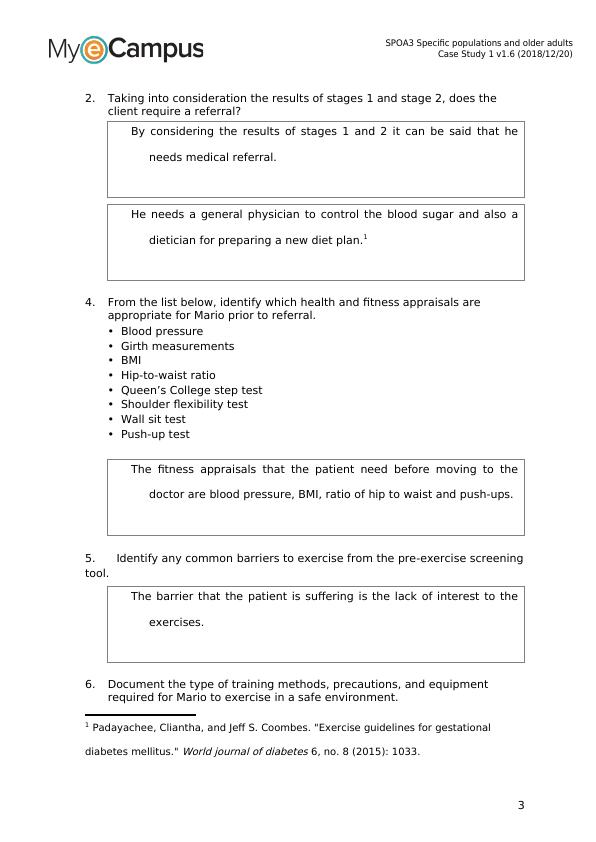
SPOA3 Specific populations and older adults
Case Study 1 v1.6 (2018/12/20)
Note: Answer this question as though Mario has been given clearance
from the AHP to exercise and as though dizziness is an issue that needs
monitoring but is not a major issue.
a) Complete the following table.
Training methods The patient require few aerobic exercises, cycling
or walking everyday.
Recovery time frames The patient may lose weight after 21 days of vigorous
exercises.
Intensity levels The patient has to walk 3.5 km/hr per day which is a
moderate one.
Volume of training He need to walk 5 kms a day or has to cycle 10 kms a
day
Frequency of training He need physical training at least 3 days a week.
The name of 5 safe compound exercises are hip hinge or deadlift, squat,
loaded carries, pull ups and push-ups.2
The name of 3 safe isolation exercises are brisk walking, lateral raises
and side lying circles as the patient is old.
The patient is suffering from diabetes and so she needs to check
diabetes after every one month.
Alison Nosila is a 60 years old female lady. From the stage 2 it can be
found that none of her family members have suffered from heart
diseases before. Her medical records show that she did not even smoke.
2 Cadore, Eduardo Lusa, and Mikel Izquierdo. "Exercise interventions in
polypathological aging patients that coexist with diabetes mellitus: improving
functional status and quality of life."
Age 37, no. 3 (2015): 64.
4
Case Study 1 v1.6 (2018/12/20)
Note: Answer this question as though Mario has been given clearance
from the AHP to exercise and as though dizziness is an issue that needs
monitoring but is not a major issue.
a) Complete the following table.
Training methods The patient require few aerobic exercises, cycling
or walking everyday.
Recovery time frames The patient may lose weight after 21 days of vigorous
exercises.
Intensity levels The patient has to walk 3.5 km/hr per day which is a
moderate one.
Volume of training He need to walk 5 kms a day or has to cycle 10 kms a
day
Frequency of training He need physical training at least 3 days a week.
The name of 5 safe compound exercises are hip hinge or deadlift, squat,
loaded carries, pull ups and push-ups.2
The name of 3 safe isolation exercises are brisk walking, lateral raises
and side lying circles as the patient is old.
The patient is suffering from diabetes and so she needs to check
diabetes after every one month.
Alison Nosila is a 60 years old female lady. From the stage 2 it can be
found that none of her family members have suffered from heart
diseases before. Her medical records show that she did not even smoke.
2 Cadore, Eduardo Lusa, and Mikel Izquierdo. "Exercise interventions in
polypathological aging patients that coexist with diabetes mellitus: improving
functional status and quality of life."
Age 37, no. 3 (2015): 64.
4

SPOA3 Specific populations and older adults
Case Study 1 v1.6 (2018/12/20)
Her blood sugar level, cholesterol level and the blood pressure are also
normal. Her basal metabolic rate is 21.8 which is quite a normal one. So
the patient do not have any risk factors related to heart disease,
diabetes or cholesterol.
2. Taking into consideration the results of stages 1 and stage 2, does the
client require a referral?
From the stage 1 and stage 2 no such risk factors of the patient can be
found. So the patient do not need any referral. She has been found to
have only one risk factor of age, her age is 60 years.
3. If so, identify which AHP is the most appropriate for referral.
The patient actually do not require any such allied health professional as
she do not have any risk factors associated with health except from
the issues that an aged person suffers. She only needs a long term
care provider who will assist the old woman in all her activities and
meet her daily needs.
5
Case Study 1 v1.6 (2018/12/20)
Her blood sugar level, cholesterol level and the blood pressure are also
normal. Her basal metabolic rate is 21.8 which is quite a normal one. So
the patient do not have any risk factors related to heart disease,
diabetes or cholesterol.
2. Taking into consideration the results of stages 1 and stage 2, does the
client require a referral?
From the stage 1 and stage 2 no such risk factors of the patient can be
found. So the patient do not need any referral. She has been found to
have only one risk factor of age, her age is 60 years.
3. If so, identify which AHP is the most appropriate for referral.
The patient actually do not require any such allied health professional as
she do not have any risk factors associated with health except from
the issues that an aged person suffers. She only needs a long term
care provider who will assist the old woman in all her activities and
meet her daily needs.
5
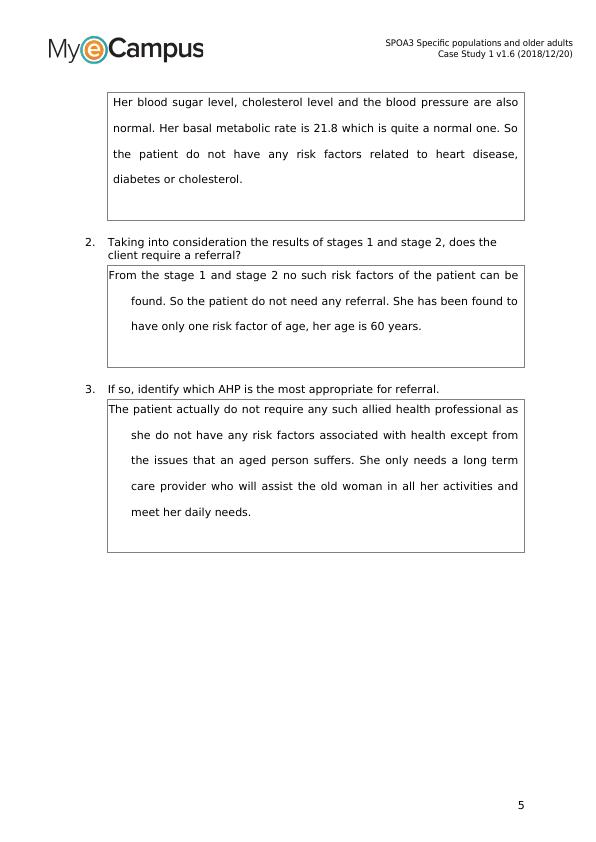
SPOA3 Specific populations and older adults
Case Study 1 v1.6 (2018/12/20)
4. From the list below, identify which health and fitness appraisals are
appropriate for Alison prior to referral.
• Blood pressure
• Girth measurements
• BMI
• Hip-to-waist ratio
• Queen’s College step test
• Shoulder flexibility test
• Wall sit test
• Push-up test
In the given case, the patient is an old lady of 60 years of age and that
also no such risk factors. At such an old age it is also not possible to
do heavier exercises, the health and fitness appraisals which can be
applied to the patient are checking the blood pressure, measuring the
basal metabolic rate and measuring the hip to waist ratio.
5. Identify any common barriers to exercise from the pre-exercise screening
tool.
The barrier that can be found is the lack of motivation or the lack of
energy. The age of the patient is 60 years and this is the reason for
which she was not able to do exercises.
6. Document the type of training methods, precautions, and equipment
required for Alison to exercise in a safe environment.
a) Complete the following table.
Training methods Only walking as she is a very aged person,
Recovery time frames the patient will start recovering her health
conditions after a few days of starting from the
exercise
Intensity levels The intensity of walking is 3.5 km/hr.
6
Case Study 1 v1.6 (2018/12/20)
4. From the list below, identify which health and fitness appraisals are
appropriate for Alison prior to referral.
• Blood pressure
• Girth measurements
• BMI
• Hip-to-waist ratio
• Queen’s College step test
• Shoulder flexibility test
• Wall sit test
• Push-up test
In the given case, the patient is an old lady of 60 years of age and that
also no such risk factors. At such an old age it is also not possible to
do heavier exercises, the health and fitness appraisals which can be
applied to the patient are checking the blood pressure, measuring the
basal metabolic rate and measuring the hip to waist ratio.
5. Identify any common barriers to exercise from the pre-exercise screening
tool.
The barrier that can be found is the lack of motivation or the lack of
energy. The age of the patient is 60 years and this is the reason for
which she was not able to do exercises.
6. Document the type of training methods, precautions, and equipment
required for Alison to exercise in a safe environment.
a) Complete the following table.
Training methods Only walking as she is a very aged person,
Recovery time frames the patient will start recovering her health
conditions after a few days of starting from the
exercise
Intensity levels The intensity of walking is 3.5 km/hr.
6
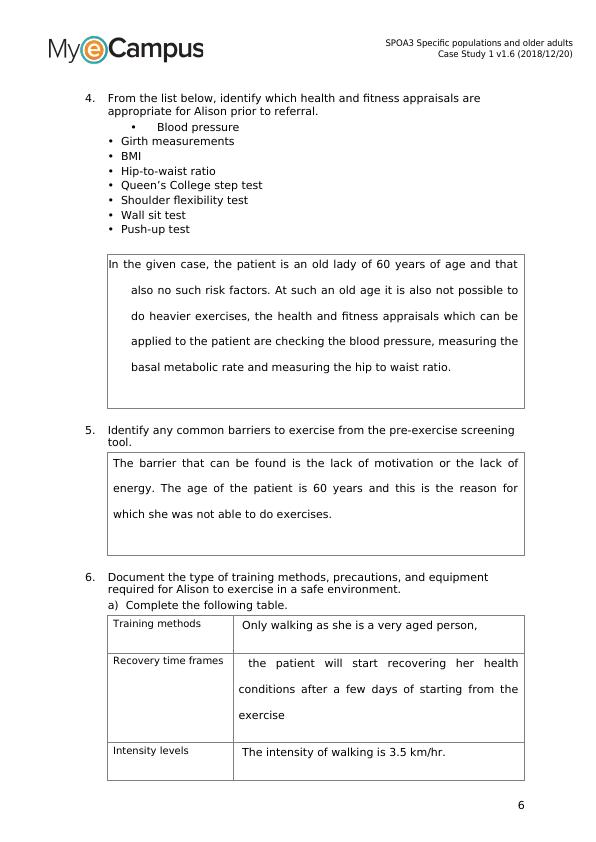
SPOA3 Specific populations and older adults
Case Study 1 v1.6 (2018/12/20)
Volume of training The patient need to walk 4kms each day of her
exercises 3.
Frequency of training The patient should get the training three days of a
week.
b) List five (5) safe compound exercises.
The name of 5 safe compound exercises are hip hinge or deadlift, squat,
loaded carries, pull ups and push-ups4.
c) List three (3) safe isolation exercises.
The name of 3 safe isolation exercises are brisk walking, lateral raises
and side lying circles as the patient is old.
7. How often you would need to review Alison’s progress.
The case need to review the progress after every 15 days to check the
blood sugar, blood pressure and level of cholesterol.
3 Bangsbo, Jens, Peter Riis Hansen, Jiri Dvorak, and Peter Krustrup. "Recreational
football for disease prevention and treatment in untrained men: a narrative review
examining cardiovascular health, lipid profile, body composition, muscle strength and
functional capacity."
Br J Sports Med 49, no. 9 (2015): 568-576.
4 Wilson, Mathew G., Georgina M. Ellison, and N. Tim Cable. "Basic science behind the
cardiovascular benefits of exercise."
Br J Sports Med 50, no. 2 (2016): 93-99.
7
Case Study 1 v1.6 (2018/12/20)
Volume of training The patient need to walk 4kms each day of her
exercises 3.
Frequency of training The patient should get the training three days of a
week.
b) List five (5) safe compound exercises.
The name of 5 safe compound exercises are hip hinge or deadlift, squat,
loaded carries, pull ups and push-ups4.
c) List three (3) safe isolation exercises.
The name of 3 safe isolation exercises are brisk walking, lateral raises
and side lying circles as the patient is old.
7. How often you would need to review Alison’s progress.
The case need to review the progress after every 15 days to check the
blood sugar, blood pressure and level of cholesterol.
3 Bangsbo, Jens, Peter Riis Hansen, Jiri Dvorak, and Peter Krustrup. "Recreational
football for disease prevention and treatment in untrained men: a narrative review
examining cardiovascular health, lipid profile, body composition, muscle strength and
functional capacity."
Br J Sports Med 49, no. 9 (2015): 568-576.
4 Wilson, Mathew G., Georgina M. Ellison, and N. Tim Cable. "Basic science behind the
cardiovascular benefits of exercise."
Br J Sports Med 50, no. 2 (2016): 93-99.
7
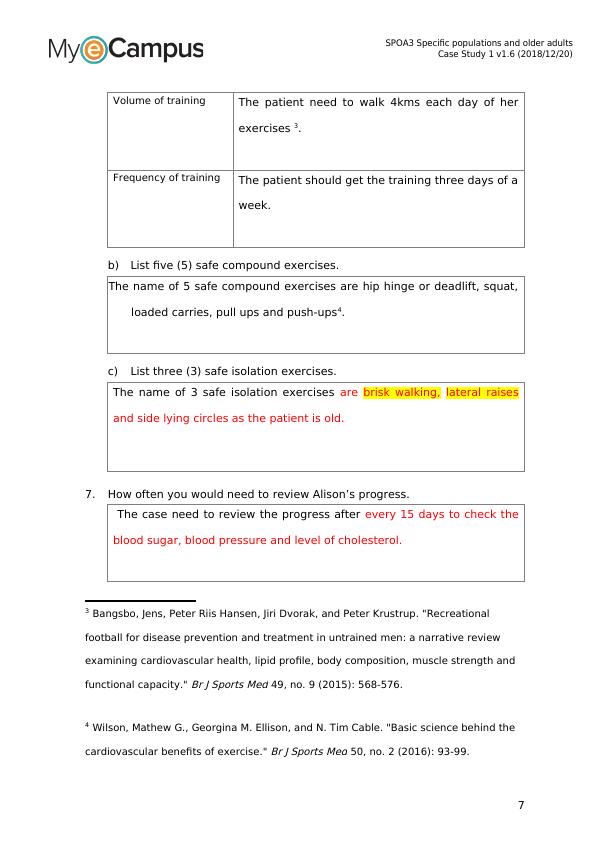
SPOA3 Specific populations and older adults
Case Study 1 v1.6 (2018/12/20)
Client 3: John Ode
Review John’s pre-exercise screening tool, and answer the following questions.
1. According to the risk stratification from stage 2, how many risk factors
does John have?
The name of the patient in the case study is John ode. He is an aged
person of 65 years of age. The family medical history of the
patient is not showing any risk of heart diseases. Even the person
do not smoke. His number of risk factors are 2 which include the
age factor because of his old age and the other risk factor is
because of his high basal metabolic rate value. The patient also
suffers from lower back pain because of driving for long periods.
2. Taking into consideration the results of stages 1 and stage 2, does the
client require a referral?
By considering the results of the stages 1 and 2, it can be said that the
person needs the help of allied health practitioners.
3. If so, identify which AHP is the most appropriate for referral.
Though the issues that the patient is suffering from are not serious but
still it is better for him to consult with a general practitioner for
treating the lower back pain.
4. From the list below, identify which health and fitness appraisals are
appropriate for John prior to referral.
• Blood pressure
• Girth measurements
• BMI
• Hip-to-waist ratio
• Queen’s College step test
• Shoulder flexibility test
• Wall sit test
• Push-up test
8
Case Study 1 v1.6 (2018/12/20)
Client 3: John Ode
Review John’s pre-exercise screening tool, and answer the following questions.
1. According to the risk stratification from stage 2, how many risk factors
does John have?
The name of the patient in the case study is John ode. He is an aged
person of 65 years of age. The family medical history of the
patient is not showing any risk of heart diseases. Even the person
do not smoke. His number of risk factors are 2 which include the
age factor because of his old age and the other risk factor is
because of his high basal metabolic rate value. The patient also
suffers from lower back pain because of driving for long periods.
2. Taking into consideration the results of stages 1 and stage 2, does the
client require a referral?
By considering the results of the stages 1 and 2, it can be said that the
person needs the help of allied health practitioners.
3. If so, identify which AHP is the most appropriate for referral.
Though the issues that the patient is suffering from are not serious but
still it is better for him to consult with a general practitioner for
treating the lower back pain.
4. From the list below, identify which health and fitness appraisals are
appropriate for John prior to referral.
• Blood pressure
• Girth measurements
• BMI
• Hip-to-waist ratio
• Queen’s College step test
• Shoulder flexibility test
• Wall sit test
• Push-up test
8
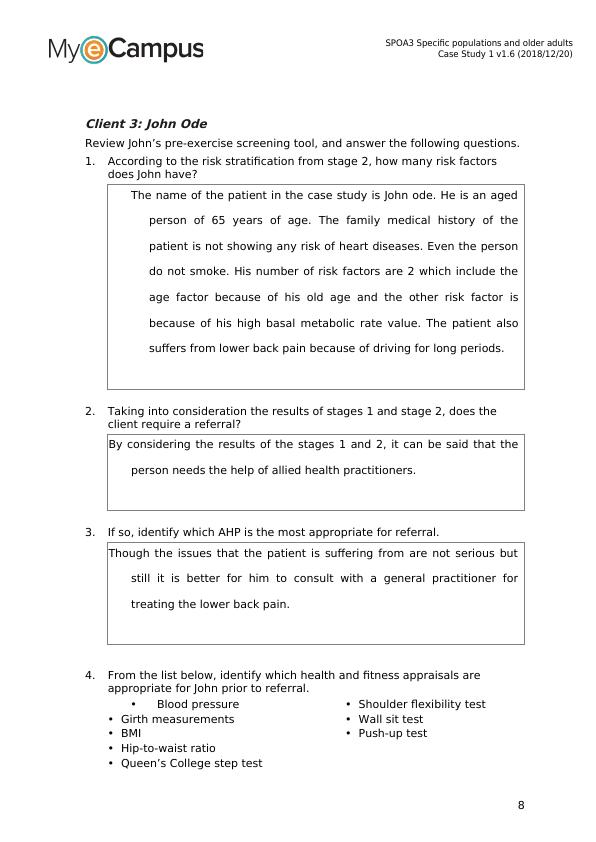
End of preview
Want to access all the pages? Upload your documents or become a member.
Related Documents
SPOA3 Specific Populations and Older Adults Case Study 1lg...
|12
|3481
|355
Specific Populations And Older Adults docx.lg...
|12
|3513
|85
SPOA3 Specific Populations and Older Adults Case Study 2lg...
|21
|2967
|442
SPOA3 Specific populations and older adults docx.lg...
|20
|2841
|35
CS2 Client Screening Case Studylg...
|18
|4244
|22
MP07 Motivational Psychology Assignment - Deskliblg...
|8
|3787
|272
